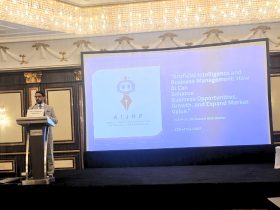Dubai – Masaader News
As recently as three decades ago, thousands of elephants strode majestically across the wildlife conservation areas of Central Africa. Today, their population has been decimated. In places like Garamba National Park in the Democratic Republic of the Congo, an estimated 1,100–1,400 individual elephants remain, down from 20,000 in the 1980s.
The reality appears to be even grimmer for the world’s tallest land animals. The flywhisk, usually made from the tail of a giraffe, is a symbol of authority in many African societies. The tail of the Kordofan giraffe in particular is highly prized as a flywhisk, and has placed this species in the crosshairs of poachers and other armed groups. Consequently, only about 40 of the giraffes remain in the Garamba park.
This grim reality has been reflected in a report released last month by the NGO Traffic, which warns of the negative impact of armed groups on wildlife in Central Africa.
“It was clear that organized poaching and trafficking of wildlife by armed non-State actors (armed groups, militia and highly-militarized poachers) is severely threatening the survival of some of the most iconic and threatened species in the region, notably Elephants and Giraffes,” said Traffic’s report, An Assessment of Poaching and Wildlife Trafficking in the Garamba-Bili-Chinko Transboundary Landscape.
The report focuses on three conservation areas in the Central African Republic and the Democratic Republic of the Congo, but poachers are also active in South Sudan’s Lantoto National Park, which lies just over the border from Garamba. Some of the armed non-state groups operating in the region include Sudan’s Janjaweed militia, Uganda’s Lord’s Resistance Army, Central African Republic’s rival Anti-Balaka and Seleka fighters, as well as Sudan’s People’s Liberation-In Opposition and poachers.
This has made conservation a dangerous undertaking. In October 2016, following an appeal by park managers working in the region, the European Union hosted a workshop to discuss how best to support conservation, provide security and help rebuild the fragile local economy.
Chimpanzees have also not been spared from the onslaught of their armed closest living relatives. For example, the report says, the population of eastern chimpanzees in eastern DR Congo has declined by 80 to 98 per cent, mainly because of poaching for bushmeat. This is attributed to demand for protein which “is particularly intense around artisanal mining and logging camps, where bushmeat is usually the main source of protein”.
“Strengthening the role of local communities in wildlife management should be at the centre of any strategy to combat illegal trade in wildlife and to secure wildlife and biodiversity for the future”
The dual effect of insufficient nutrition, coupled with the pollution arising from mining, is only likely to exacerbate the threat to the region’s biodiversity resulting in a downward spiral that could jeopardize future livelihoods of numerous local communities.
“The importance of engaging local communities in fighting poaching, and of enhancing their alternative livelihoods, has now been widely recognized across various national, regional and global fora” said UN Environment’s Bianca Notarbartolo. “But such commitments have yet to be matched by enough effective implementation.”
“Strengthening the role of local communities in wildlife management should be at the centre of any strategy to combat illegal trade in wildlife and to secure wildlife and biodiversity for the future,” she added.
However, the Traffic report says a lifeline still exists to salvage the situation:
“Fortunately, there are dedicated and competent conservation agencies on the ground, and these organizations must be fully supported (financially, logistically and politically) so that they can continue to defend the wildlife and [regional] ecosystem against the enormous pressures currently being exerted upon them”, it says.
It also recommends promotion of public information campaigns to highlight endangered and other protected species, legislation, law enforcement and incidents of corruption. It also advocates detailed investigation into wildlife trafficking in southeast Central African Republic and support for alternative community livelihoods as well as cross-border cooperation between the affected states.
In May 2016, UN Environment and other partners in the UN system launched the Wild For Life campaign, which has been raising awareness, promoting the enactment and enforcement of laws, and increasing support for efforts by local communities to halt the illegal trade in wildlife. Elephants and Rhinos are among the species targeted by the campaign.











